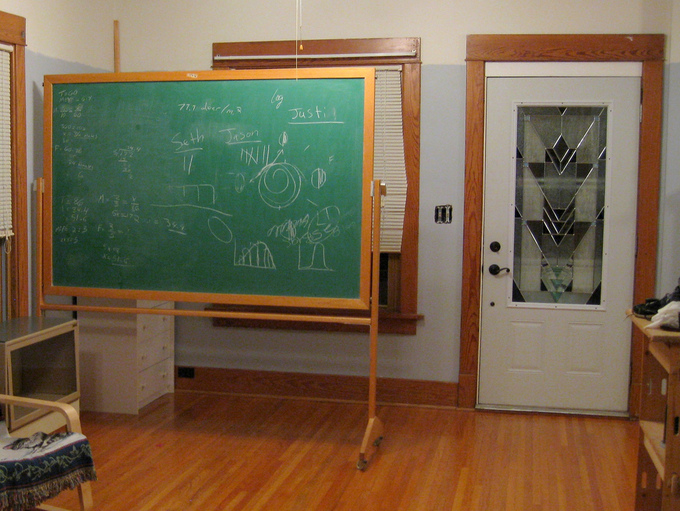Visual aids such as chalkboards, flipcharts, and transparencies are used by presenters to help weave their words and images together into a cohesive message.
Using visual tools effectively during a presentation helps speakers appear prepared, professional, interesting, and credible. Writing tools and imagery also help audience members focus on and remember the presenter's major points, as well as better understand the presenter's argument.

1a. Chalkboards: From School to the Workplace
Although we often think of chalkboards in academic or teaching settings, chalkboards (or dry boards) are also commonly used in business environments.
Chalkboards are reusable writing surfaces where text and drawings are made using sticks of calcium sulfate or calcium carbonate known as chalk. Chalkboards were originally made of smooth, thin sheets of black or dark grey slate stone. Modern versions are often green because the color is considered easier for reading.
Organizations typically use dry boards, which use dry erase markers for easy application and removal. These boards can be used for presentations, as well as advertisements or record-keeping.
In presentations, chalkboards and dry boards provide significant flexibility for recording audience responses and jumpstarting discussions. This spontaneity allows for fast, simple and easy use by presenters who may not be familiar or comfortable with presentation software tools.
On the other hand, writing on a chalkboard or dry board can delay presentations. Presenters may be tempted to speak to the board instead of the audience. Also, the chalkboard's size limits visibility for large groups. Presenters with poor spelling or illegible handwriting can also pose problems for audience members.
1b. Flipcharts in Presentations
Like chalkboards and dry boards, flipcharts have a low learning curve, allowing anyone with the ability to write to quickly convey information to audience members.
Flipcharts are typically stationary items consisting of pads of large paper sheets fixed to the upper edge of a whiteboard. These are typically supported on a tripod or four-legged easel. Invented by Peter Kent, who built one to help him in a presentation, flipcharts are commonly used for presentations.
Flipcharts come in various forms, including:
Recently, scientists have developed a digital self-writing flipchart which writes word-for-word everything it is instructed to record. Self-heightening flipcharts such as the POGO system are also being introduced into public use. However, traditional flipcharts where text is usually hand-written with marker pens are still widely used in organizations.
1c. Transparencies in Business, Academia, and the Church
In today's information age, digital presentations and slideshows are by far some of the most widely used visual aids in public speaking. However, transparencies are still used by a variety of organizations.
A transparency, also known in industrial settings as a "viewfoil" or "foil," is a thin sheet of transparent flexible material, typically cellulose acetate, onto which figures can be drawn. These are then placed on an overhead projector to display to an audience.
Many companies and small organizations use a system of projectors and transparencies in meetings and other groupings of people; though this system is being largely replaced by LCD projectors and interactive whiteboards.
In academia, mathematics and history classes traditionally used transparencies to illustrate a point or problem. Math classes in particular used a roll of acetate to illustrate sufficiently long problems and create illustrations that were difficult to do on computers due to a lack of math symbols on standard computer keyboards.
Nevertheless, more colleges are switching to digital projectors and PowerPoint presentations. In churches and other religious organizations, religious leaders used transparencies to show sermon outlines and illustrate certain topics such as Old Testament battles and Jewish artifacts during worship services.
While transparencies allow presenters to maintain eye contact with the audience, and multitask (e.g. take notes), they often appear plain looking with no motion or sound. Moreover, transparencies must be shown in dim lighting, which may potentially cause visibility problems for viewers. As a result, overhead projectors are quickly becoming outdated and being replaced by computer-based presentation tools.
Source: Boundless. "Chalkboards, Flip Charts, and Transparencies." Boundless Communications Boundless, 17 Mar. 2017. Retrieved 2 Jun. 2017 from https://www.boundless.com/communications/textbooks/boundless-communications-textbook/preparing-and-using-visual-aids-16/types-of-sensory-enhancements-82/chalkboards-flip-charts-and-transparencies-313-4200/